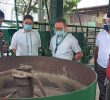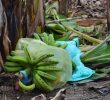ZAMBOANGA CITY�If a sample of people was asked to identify one local product that cuts across all socio-cultural groups in the Philippines, canned sardines would most likely be on the top of everyone�s list. Practically all Filipinos�from the health-conscious, laptop wielding yuppies in Makati, to the robust middle-class segment of Cebu, to the low-income families in Surigao�love sardines because of their rich flavor, affordable cost and nutritional value.
Perhaps unknown however, to most consumers, is that the canned sardines which find their way to the shelves of the neighborhood sari-sari stores or favorite supermarkets are most likely produced in Zamboanga City. Through the years, this city has been the country�s leading producer of canned sardines, and is home to eight of the nation�s canning factories, which employ around 10,000 workers. Zamboanga�s sardine industry generates over P3 billion in revenues annually for the local economy.
Similar to the thriving tuna industry in General Santos City, Zamboanga�s sardine industry has become a major pillar of the city�s economy. Thus, developments affecting its operations create a significant impact on the area�s fiscal health and consequently, on the economic life of its residents.
Crisis begins
Though it has enjoyed robust growth over the years, Zamboanga�s sardine industry is facing a potential crisis, according to an assessment conducted by USAID�s Growth with Equity in Mindanao (GEM) Program at the request of the Mindanao Economic Development Council (MEDCo). MEDCo, in turn, requested the study to clarify the reasons underlying a five-month shut down of the industry by local canners in 2005; an action that severely affected the livelihoods of residents who where directly or indirectly involved in the industry�s operations, including fisherfolk , cannery workers and providers of various ancillary services.
The situation, the GEM assessment explained, was due to the escalating operating costs of producers, even as fish prices remained relatively constant. Fuel prices jumped from P17 per liter in 2004 to P34 per liter in 2005, while daily wages rose form P165 to P196 when fish handlers were reclassified as non-agricultural workers. Canning operators could not significantly increase the buying price of fish because of the increasing cost of imported tin cans and consumer resistance to retail price increases. Wage and fuel increases severely eroded the profits of fisherfolk since about 80 percent of their catch is sold to local canneries. From the period 2004 to 2005, the price of fish sold to the canneries remained unchanged at P11 to P12 per kilo.
At least two canneries experienced a slump in sales towards the end of 2005, when the prices of a 150 gram can reached P9.75. According to the University Asia and the Pacific, lower-income families began to replace sardines with the lower-priced noodles as their staple food. This shift in buying habits may have negative ramifications for family health since canned sardines are the most affordable source of protein available to most families.
Over-fishing in the Sulu Sea
But even more alarming, the GEM assessment revealed, was that the local sardine fleet might be fishing beyond sustainability levels. The Sulu Sea is the primary fishing ground of fleets coming from Zamboanga Del Norte, Zamboanga City, Basilan, Sulu and Tawi-Tawi.
Based on a National Stock Assessment Program conducted by the Bureau of Fisheries and Aquatic Resources (BFAR) for the period 1999 to 2005 exploitation rates for the Indian sardine � the main species used for making canned sardines � were calculated at 0.60 to 0.70, which meant that over 60 percent of the actual biomass of the fish was already being caught. An exploitation rate beyond 50 percent endangers the sustainability of the fish stocks.
The industry�s fishing fleet consists of 61 commercial purse seines and ringnet vessels and 36 large municipal bancas (outrigger boats) using the ringnet and bagnet systems. Each of these commercial vessels is supported by two carriers and two lightboats.
Figures provided by the Southern Philippines Deep Sea Fishing Association (SOPHIL) for the period 2002 to 2005 showed that the group�s 16 purse seine vessels recorded average catches of 10.6 to 12 metric tons per fishing set. Yearly sardine catches of these vessels averaged 215,000 metric tons, which comprised 70 percent of the fleet�s total catch for all species. The 36 commercial bancas caught an average of one metric ton of fish daily. Based on 200 fishing nights per year, the banca fleet produced 7,200 metric tons yearly. Finally, the municipal sardine fleet�s 200 large bancas caught an average of 0.5 metric ton per day. The fleet had a combined annual catch of 20,000 metric tons.










